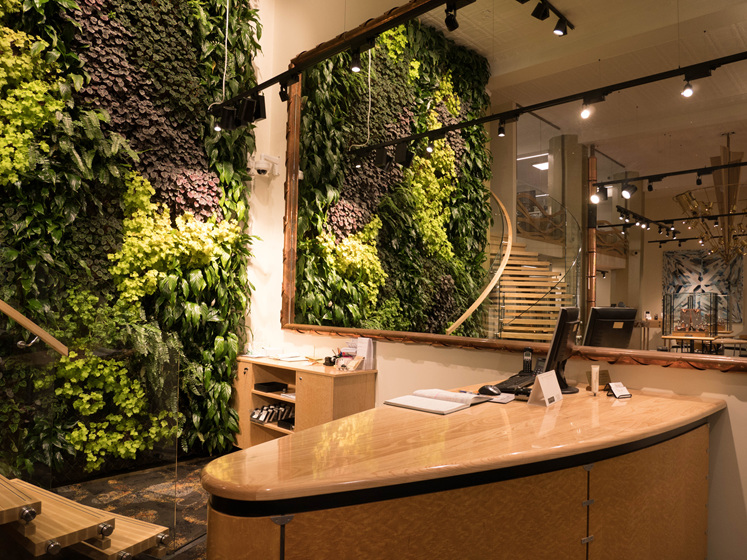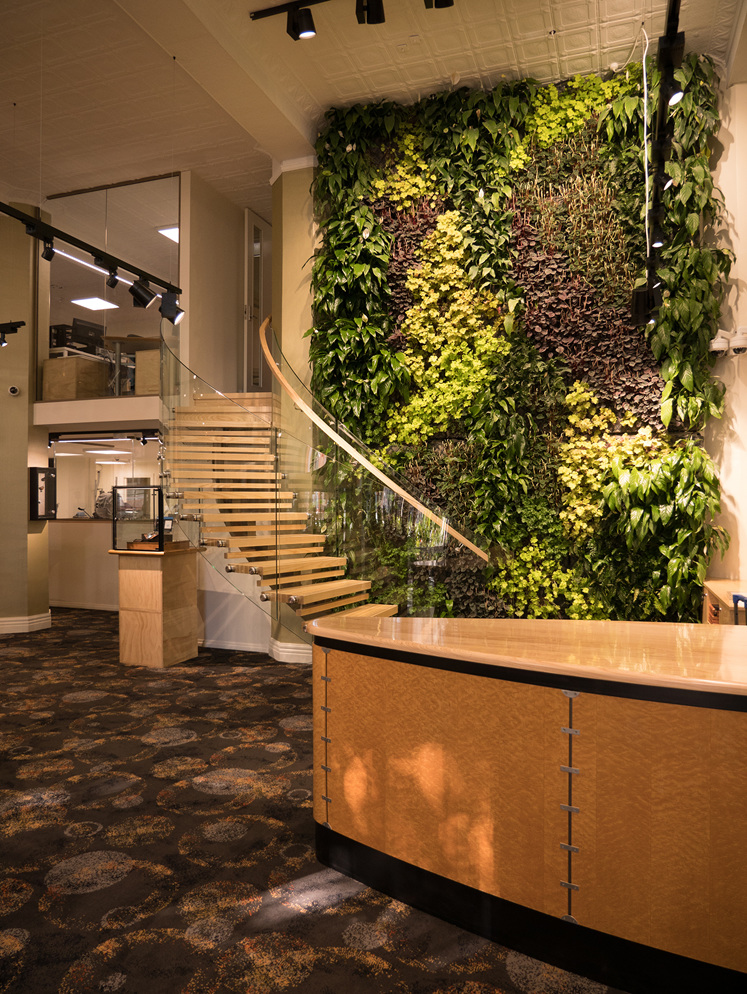Green Walls - Your Living Artwork
When designing our new store fit-out we decided our space needed to reflect our character, creativity and originality. We wanted it to be very different to what people normally expect in a jewellery store and unlike any other in the world. The space needed to harmoniously combine a modern retail gallery, a new state of the art manufacturing workshop and our international design company.
We chose to feature a green living wall in the entrance to our store to create a real and genuine experience which reflects our brands values. The green wall is a way to return to basics, embrace the beauty of nature and provide a comforting, creative and natural environment for our clients and staff.
The living wall, gallery and workshop are designed to provide clients with a meaningful experience in a relaxed and inspiring setting. Our clients are not simply buying a piece of jewellery, but creating a tangible symbol of their story.
Green walls - your living artwork
Originally published by The Dominion Post
THEY’RE described as a verdant pieces of art that will bring a space to life and they are increasingly popping up in homes across the country.

The Village Goldsmith commissioned this 5m x 3m green wall that sits in its downtown Wellington store and without exception, people comment on how much they love it.
Living walls, or green walls, are self-sufficient vertical gardens that are grown in a structural system attached to the interior or exterior of a building.
It’s a concept that is taking off worldwide, and in New Zealand, landscaping and green wall experts Natural Habitats have been busy installing them in both the commercial and residential sector.
Wellington regional manager Tim Broadbent says bringing nature in the form of living walls into spaces full of hard surfaces and materials can breathe life into it.
They can add interest to an otherwise plain inside wall in living rooms, hallways and bathrooms, for example.
Plant edible greens and homeowners have a living splashback in their kitchen, or a herb garden right outside the kitchen window.
Outdoors, living walls can take a front entrance from boring to inspiring, they can provide the perfect screening from neighbours or brighten up a stark exterior wall.
They are a great replacement for pots and are a good space saver in areas where vertical works better.
‘‘Living walls are definitely catching on, not for just the aesthetics, but also for their health and wellbeing benefits,’’ says Tim.
Going green softens urban environments surrounded by concrete, traffic, noise and pollution, acting as a tonic to ease stress and fatigue, increasing productivity and reducing symptoms of discomfort.
Because plants filter the air taking in toxins and releasing oxygen, living walls purify the air.

They add extra insulation and therefore provide significant energy savings, with some studies showing interior green walls can cut electricity bills by up to 20 percent.
They dampen noise pollution and improve the acoustics of a room - leaves of plants attenuate sound by reflecting, refracting and absorbing acoustic energy in small amounts.
And then there’s sustainability – vegetation on walls attract organisms like butterflies and bees, therefore encouraging biodiversity.
Since Natural Habitats was established 30 years ago, the leader and innovator in green technology has installed numerous vertical gardens and green roofs in hotels to hair salons, as well as public spaces and homes around the country.
Tim’s team has even installed the largest green wall in New Zealand – a 300 square metre living artwork in Auckland’s Britomart.
It causes people to stop and take time out to look at the detail of it, and provides office occupants with a sense of connection with the natural environment, says Tim.
Then there’s the installation of Novotel’s 60 square metre native interior green wall, a doublesided lush green wall at a hair salon, a native green exterior wall of the same size, and a 6m high external green wall, all believed to be firsts in New Zealand.
‘‘These living walls really are creating a visually stunning green scape that breathes life back into homes and workplaces,’’ says Tim. He’s even got his own on his Te Horo Beach property. ‘‘I filled mine with petunias last year and it looked amazing, it was beautiful.’’
The team has installed one at Sir Peter Jackson’s office too, which acts as a screen over an exterior plastered white wall that he looks onto from inside.
Jeweller, The Village Goldsmith, commissioned a 5m x 3m green wall that sits in its downtown Wellington store and without exception, people comment on how much they love it, says Tim.
Whatever their intended purpose, the beauty of living walls is that there is no height or size restriction.
Natural Habitat’s living walls come in 2mx1m panels, forming a lightweight, automated system that provides both irrigation and soluble nutrients.
The system is applied to an existing building and is modular, which enables ease of maintenance and substitution of plant ‘cells’. The panels themselves are made of extruded aluminium mesh, which are infilled with polystyrene and charcoal chips that help to store nutrients and then sealed off. Plants are inserted through the mesh and into the polystyrene, and grown in the Natural Habitat nursery. Firstly, the panels are laid flat and watered. When plants are fully rooted through, the panels are titled to allow the roots to travel down and shoots to go up. Within three months the structure is covered in leaves and greenery, the stage when it’s ready for installation.
Before going green though, homeowners must consider a few things first, says Tim.
Pick the right plants - for an indoor green wall, choose plants that can tolerate a lower light level, such as ferns, and philodendrons.
Herbs are ideal for outside kitchens, but consider the fact that some, like parsley, would need replacing regularly.
Most living walls will happily nurture natives, ground cover plants, Astelias, Griselinia and Pseudopanax or even Rata. ‘‘You can pretty much plant anything you find growing as epiphytes in the canopy of a tree,’’ says Tim.
Watch light levels though, as plants need light to grow and some need more than others. Consider directing indoor lights at a planted wall, which Tim says will look stunning.
Think about drainage too - with an irrigation line going into the system, it needs somewhere to drain.
Also consider the height of the living wall, as access to the top will be needed to maintain plants.
Maintenance shouldn’t be onerous, but pruning, feeding and watering will still apply, says Tim. ‘‘Establishing a good maintenance routine will greatly increase the success of the wall.’’ And a well-maintained, well-loved living wall will reward its owners with a spectacular display, he says. ‘‘Living walls are just stunning to look at, beneficial to be around and they instantly add value.’’





